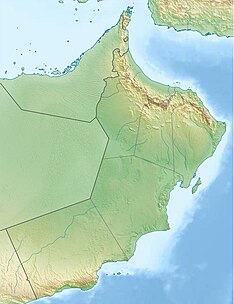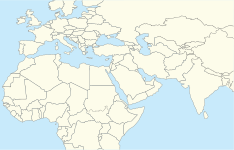Jebel Akhdar (Oman)
| Jebel Akhdar | |
|---|---|
Arabic)) | |
| Geography | |
| Location | |
| Parent range | Al-Hajar Mountains |
The Jebel Akhdar (
Geology and geography
This mostly
An old stronghold on the inland side of the mountain is Birkat al-Mawz, or Pool of the Plantains, with a layout similar to the nearby Jabrin palace.[7]
"Poised across the yawning mouth of a great pass into the mountains, Birkat al-Mawz was one of the fortresses of the Bani Riyam tribe which controlled the mountain heartland. Collapsing into ruin until recently, the mud-brick fortress and its painted ceilings are now well on the way to restoration."
— Aramco World.
The area is about a 45-minute drive from
Ecology
Jebel Ahkdar is in Al Hajar montane woodlands ecoregion. The plant communities on the mountain vary with elevation. Shrublands and dry grasslands are found from 450 to 1,300 meters elevation. The grasses and shrubs are adapted to arid conditions, and include many drought-deciduous and succulent plants. Typical shrubs include Convolvulus acanthocladus, Euphorbia larica, Grewia tenax subsp. makranica, Jaubertia aucheri, Maerua crassifolia, Moringa peregrina, and Pseudogaillonia hymenostephana.[14]
Semi-evergreen woodlands of sclerophyllous trees are found between 1,350 and 2,350 meters elevation. Common trees and shrubs include Sideroxylon mascatense, Dodonaea viscosa, Olive (Olea europaea), Ebenus stellatus, Grewia villosa, Juniperus seravschanica, Myrtus communis, and Sageretia spiciflora.[14]
Above 2300 meters elevation, open woodlands of juniper (Juniperus seravschanica) predominate, with the shrubs Cotoneaster nummularius, Daphne mucronata, Ephedra pachyclada, Euryops arabicus, Lonicera aucheri, Periploca aphylla, and Sageretia spiciflora.[14]
Farming
The mountain is a traditional farming area, with mountain springs providing sufficient for irrigation needs. However, climate change has reduced annual rainfall and increased nighttime temperatures.[15]
History
Between 1954 and 1959, the area became a site of the
In August 2011, Sultan Qaboos designated Jebel Akhdar a nature reserve in a bid to conserve its unique yet fragile biodiversity. A decree issued by Sultan Qaboos established the 'Jebel Akhdar Sanctuary for Natural Sceneries'. The Minister of Environment and Climate Affairs has authority to draft guidelines regulating access and developmental activity within the reserve.[17]
Since 2011, the mountain has featured as the principal climb in the Tour of Oman road bicycle race.[18] In the area, several important rock art sites, with figures dating back to 6,000 years ago, have been discovered and studied.[19]
See also
References
- ^ a b "Mountains in Oman". Ministry of Tourism, Sultanate of Oman. Archived from the original on 2011-07-15. Retrieved 2018-12-19.
- ^ "'Persian Gulf. Handbooks prepared under the direction of the Historical Section of the Foreign Office - no 81' [7] (13/94)". Qatar Digital Library. 2014-08-21. Retrieved 2016-07-09.
- ^ "Al Jabal Al Akhdar (Green Mountain)". Ministry of Tourism, Sultanate of Oman. Archived from the original on 2022-03-19. Retrieved 2020-02-02.
- ^ "Al Jabal Al Akhdar". www.nizwa.net. Archived from the original on 2016-03-19. Retrieved 2016-07-09.
- ISBN 978-1-7417-9145-7.
- ^ "Great outings for the summer months: Jebel Shams in Oman". OutdoorUAE. 2012-06-12. Archived from the original on 2016-08-16. Retrieved 2016-07-09.
- ^ "Saudi Aramco World: Fortified Oman". archive.aramcoworld.com. Retrieved 2016-07-09.
- ^ "Rosewater distillation, profession of generations in Jebel Akhdar". Muscat Daily News. Archived from the original on 2016-09-17. Retrieved 2016-07-09.
- ^ "Oman's rose water: A history of tradition". 2010-12-08. Retrieved 2016-07-09.
- ^ "Fruits of the Jabal". www.nizwa.net. Archived from the original on 2015-10-24. Retrieved 2016-07-09.
- ^ "GIAHS - Globally Important Agricultural Heritage Systems: Al Jabal Al Akhdar Aflaj and Terraced Fields System, OMAN". www.fao.org. Archived from the original on 2016-08-20. Retrieved 2016-07-09.
- ^ "'Gazetteer of Arabia Vol. II' [1576] (655/688)". Qatar Digital Library. 2014-10-22. Retrieved 2016-07-09.
- ISBN 978-1-3172-4209-3.
- ^
- ^ Ruth Kamnitzer (18 March 2024). "Oman's mountain oases offer ancient farming lessons for a warming future". Mongabay. Retrieved 16 April 2024.
- ^ Pike, John. "The Jebel Akhdar War Oman 1954-1959". www.globalsecurity.org. Retrieved 2016-07-09.
- ^ Staff Report (2011-08-18). "Oman's 'Green Mountain' declared nature reserve". Gulf News. Retrieved 2016-07-09.
- ^ Puddicombe, Stephen. "Tour of Oman 2015 preview". Cycling Weekly. Retrieved 14 February 2015.
- ^ Fossati, Angelo Eugenio. "Rock Art in Jebel Akhdar, Sultanate of Oman, first overview and state of research, TRACCE Online Rock Art Bulletin". Retrieved 29 August 2015.



